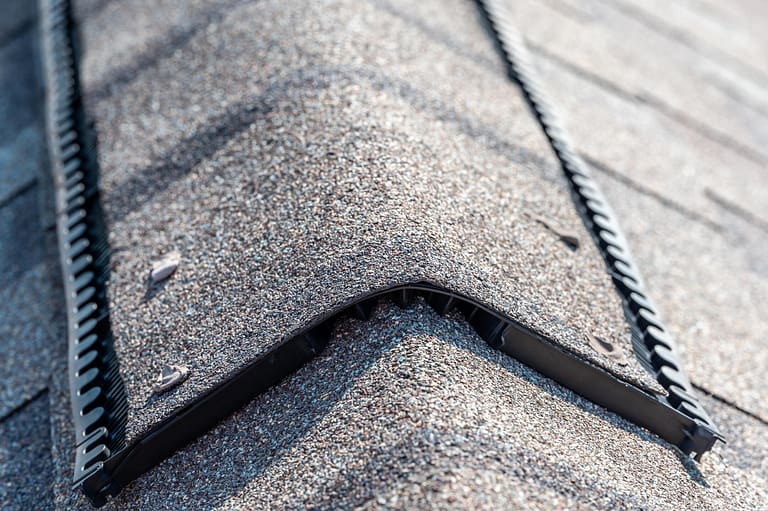
Granule loss on shingles is a common issue that many homeowners face, leading to potential damage and costly repairs. This blog post explores the top causes of granule loss, such as weather conditions, aging roofs, improper installation, and low-quality shingles.
We will also discuss preventive measures and solutions to address this problem before it escalates.
Key Takeaways
- Weather conditions, aging and wear, poor quality shingles, and improper installation are the top causes of granule loss on shingles.
- It’s crucial to schedule a professional inspection with a trusted roofing contractor to determine the extent of damage to your roof and replace any damaged or worn shingles with high-quality materials.
- Choosing high-quality shingles and ensuring proper installation by a reliable roofing contractor can prevent future problems with wind damage or leaks due to improperly installed materials.
- Regular maintenance tasks such as gutter cleaning can help prevent debris buildup that can cause granule loss over time.
Top Causes of Granule Loss on Shingles
Weather conditions, aging and wear, poor quality shingles, and improper installation are the top causes of granule loss on shingles.
- Weather Conditions
Weather conditions play a significant role in the loss of granules on shingles, impacting the overall durability and longevity of roofing materials. Extreme weather events such as hail storms can be particularly damaging, leading to accelerated granule loss and reduced water flow on the roof surface.
In addition to storm damage, daily exposure to ultraviolet (UV) rays can cause shingles to weaken over time, resulting in further granule detachment. This is particularly true for roofs with slopes facing the sun, which experience more extreme temperature fluctuations throughout the year.
Temperature fluctuations occur during summer months when UV radiation is at its highest intensity level, and during winter when the freeze-thaw cycle occurs frequently.
- Aging and Wear
One of the top causes of granule loss on shingles is the natural aging and wear process that all roofs experience over time. As asphalt shingles age, they lose flexibility and may develop cracks or splits, increasing susceptibility to granule erosion.
Moisture damage is another common culprit when it comes to granule loss due to aging and wear. When water gets trapped under or inside shingles, it can cause further deterioration and hasten the wearing process.
In some instances, hailstorms may directly impact shingle surfaces causing noticeable distress in the form of chips or dents, ultimately contributing to accelerated granule loss.
- Poor Quality Shingles
One of the top causes of granule loss on shingles is the use of poor-quality materials. Inexpensive or low-grade shingles are often manufactured with subpar materials and workmanship, leading to faster deterioration.
For instance, a homeowner who opts for budget-friendly shingles in an attempt to save money might face costly repairs or even total replacement due to premature granule loss.
This is because cheap shingles have weaker structures and are more susceptible to damage from harsh weather conditions like windstorms, rain, snow, or extreme temperatures.
- Improper Installation
Improper installation is the leading cause of granule loss on shingles. When shingles are installed incorrectly, they can become loose and shift position. This movement can lead to the gradual wearing away of the granules that protect the underlying layers from weather damage.
To ensure proper installation, you’ll want to hire a professional roofer who follows manufacturer guidelines and uses quality materials. A reputable roofing contractor will avoid shortcuts such as skipping steps in the installation or failing to use enough fasteners to secure the roof properly.
What To Do Next

To address granule loss on your shingles, schedule a professional inspection and consider replacing any damaged or worn shingles with high-quality materials. Proper installation and ongoing maintenance can help prevent further damage to your roof.
Schedule A Professional Inspection
To determine the extent of damage to your roof and prevent further issues, it’s essential to schedule a professional inspection with a trusted roofing contractor. Professionals can examine your shingles’ condition, including granule loss, and provide appropriate recommendations for repairs or replacement.
Granule loss on shingles is often a sign of underlying damage that may require immediate attention. A professional roofer can assess whether granule loss signifies aging wear-and-tear or if there is more severe weather-related damage like hail impact.
They’ll check to see if all parts of the roof are properly sealed and secure and inspect gutters and downspouts for any debris blockages.
Replace Damaged Or Worn Shingles
If you notice granule loss on your shingles, it might be time to replace damaged or worn shingles. Damage caused by weather conditions, like hail storms and strong winds can wear out the shingles over time, leading to granule loss.
General wear and tear can add to the problem. The best way to maintain the integrity of your roof is by having a professional inspect it regularly, looking out for damage that may go unnoticed until it’s too late.
To ensure that you’re getting high-quality roofing materials that will last for years without losing their granules quickly, choose reputable brands when purchasing new shingles.
Proper installation by a reliable roofing contractor will also prevent future problems with wind damage or leaks due to improperly installed materials.
Choose High-Quality Shingles
Choosing high-quality shingles is a crucial step in preventing granule loss on your roof. Asphalt shingles are a popular and durable roofing material, but poor-quality shingles may have fewer granules and wear out faster.
When selecting shingles, consider their weather performance, durability, and resistance to algae growth.
It’s also essential to ensure that the installation is proper and well-maintained to prevent any damage or premature aging of your roof. Additionally, replacing damaged or worn shingles as soon as possible can help reduce excess granule loss and prolong the life of your roof.
Proper Installation And Maintenance

Proper installation and maintenance are key factors in preventing granule loss on shingles. When choosing a roofing contractor, ensure they have experience with asphalt shingle roofs and understand the importance of proper installation techniques.
Basic maintenance tasks such as gutter cleaning can help prevent debris buildup that can cause granule loss over time. It’s also important to inspect your roof periodically for signs of wear or damage, particularly after severe weather events like hail storms.
Promptly replacing damaged or worn shingles is critical for preventing further damage and protecting against future granule loss.
Conclusion
In conclusion, if you notice granule loss on your shingles, it’s crucial to take action as soon as possible. Whether from weather conditions, aging, wear, poor quality shingles, or improper installation, there are steps you can take to fix the problem.
Schedule a professional inspection today and replace any damaged or worn shingles with high-quality ones. Proper installation and maintenance can also help prevent future granule loss.






